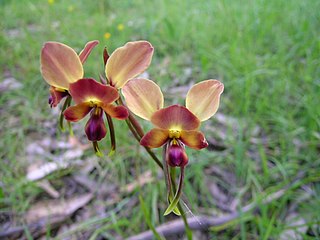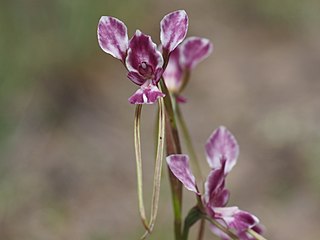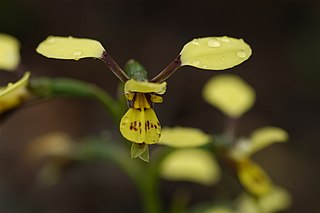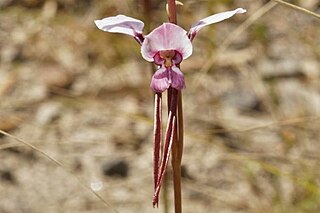Diuris maculata, commonly known as the spotted doubletail is a species of orchid which is endemic to New South Wales. It has up to two or three folded leaves and a flowering stem with up to eight yellow flowers with brown to blackish markings. It is similar to D. pardina which has darker flowers with larger brown markings.

Diuris sulphurea, commonly called the tiger orchid or hornet orchid, is a species of orchid which is endemic to eastern Australia. It has up to three leaves, and a flowering stem with up to seven bright yellow flowers with dark brown markings.

Diuris aequalis, commonly called the buttercup doubletail, is a species of orchid which is endemic to New South Wales. It has two rolled leaves and spikes of two to five golden-yellow to orange flowers and is classified as "vulnerable".

Diuris orientis, commonly called the wallflower orchid or eastern wallflower orchid, is a species of orchid which is endemic to eastern Australia. Like others in the genus Diuris, it has two ear-like petals and is similar to the common donkey orchid of Western Australia with which it has been confused. This species is found in New South Wales, Victoria, South Australia and Tasmania and its stalk-like petal "claw" is shorter in than those of D. corymbosa.

Diuris venosa, commonly known as the veined doubletail is a species of orchid which is endemic to New South Wales. It has a few thin, erect leaves and up to four white to lilac-coloured flowers with deep red to purple blotches and lines.

Diuris abbreviata, commonly known as the lemon doubletail, is a species of orchid that is endemic to eastern Australia. It has two or three leaves and a flowering stem with up to nine yellow flowers with darker markings.

Diuris dendrobioides, commonly known as the wedge diuris, is a species of orchid which is endemic to eastern Australia. It has one or two leaves and a flowering stem with up to six pale lilac-coloured to mauve flowers with darker markings.

Diuris praecox, commonly known as the early doubletail, Newcastle doubletail or rough doubletail is a species of orchid which is endemic to New South Wales. It has two or three grass-like leaves and up to ten light yellow flowers with a few dark brown marks. It is threatened by urbanisation.

Diuris punctata, commonly known as the purple donkey orchid is a species of orchid which is endemic to south-eastern continental Australia. It has two grass-like leaves and up to ten purple or mauve flowers, often with darker, sometimes yellow marks. A yellow form from near Guyra is probably now extinct.

Diuris arenaria, commonly known as the Tomaree donkey orchid or sand doubletail is a species of orchid which is endemic to a very small area of New South Wales. It has two grass-like leaves and up to nine mauve or light purple and white flowers. It has a very limited distribution near Newcastle.
Diuris callitrophila, commonly known as the Oaklands doubletail or Oaklands diuris, is a species of orchid which is endemic to a small part of southern New South Wales. It has two or three leaves and up to nine whitish and mauve flowers with darker markings and unusually long lateral sepals.
Diuris disposita, commonly called the Macleay River doubletail or Willawarrin doubletail, is a species of orchid which is endemic to a small area in New South Wales. It has one or two linear leaves at its base and up to seven yellow flowers with brown markings. Only about fifty plants survive in grassy forest near Kempsey.
Diuris flavescens, commonly called the pale yellow doubletail or Wingham doubletail, is a species of orchid which is endemic to a small area in New South Wales. It has two linear leaves at its base and up to five pale yellow flowers with dark brown markings. Fewer than 200 plants survive in grassy forest near Wingham.
Diuris luteola, commonly called the northern doubletail, is a species of orchid which is endemic to Queensland. It has a single linear leaf at its base and up to six pale yellow flowers with a few brown markings. It grows in shallow, stony soil on tablelands in eastern parts of the state.
Diuris oporina, commonly called the autumn donkey orchid or northern white donkeys tails is a species of orchid that is endemic to Queensland. It has a single tapering, linear leaf at its base and up to ten white flowers with mauve to purple markings. It grows in the drier parts of the tablelands in Far North Queensland.

Diuris palustris, commonly known as the swamp doubletail or swamp diuris is a species of orchid which is endemic to south-eastern Australia. It has a tuft of between eight and ten twisted leaves and up to four yellow flowers with brown spots and blotches marks and blotches.
Diuris parvipetala, commonly known as slender purple donkey orchid, is a species of orchid that is endemic to eastern Australia. It usually has two leaves at its base and up to nine relatively small, whitish to mauve flowers with purple markings. It is an uncommon species found in northern New South Wales and southern Queensland.
Diuris platichila, commonly known as the Blue Mountains doubletail, is a species of orchid that is endemic to a few isolated places in the Blue Mountains in New South Wales. It has two leaves and up to eight yellow flowers with dark markings on the dorsal sepal and labellum. It has relatively long, thin lateral sepals and the central lobe of the labellum is wedge-shaped. It forms hybrids with other species of Diuris.

Diuris pulchella, commonly called the beautiful donkey orchid is a species of orchid that is endemic to the south-eastern part of the south-west of Western Australia. It has two or three leaves at its base and up to five bright yellow and mauve flowers described as "exquisite", "spectacular" and "attractive". It grows in shallow soil on granite outcrops near Esperance.
Diuris striata is a poorly-known species of orchid that is endemic to New South Wales. It has a two grass-like leaves and about four mauve flowers with dark purple streaks on the labellum.











